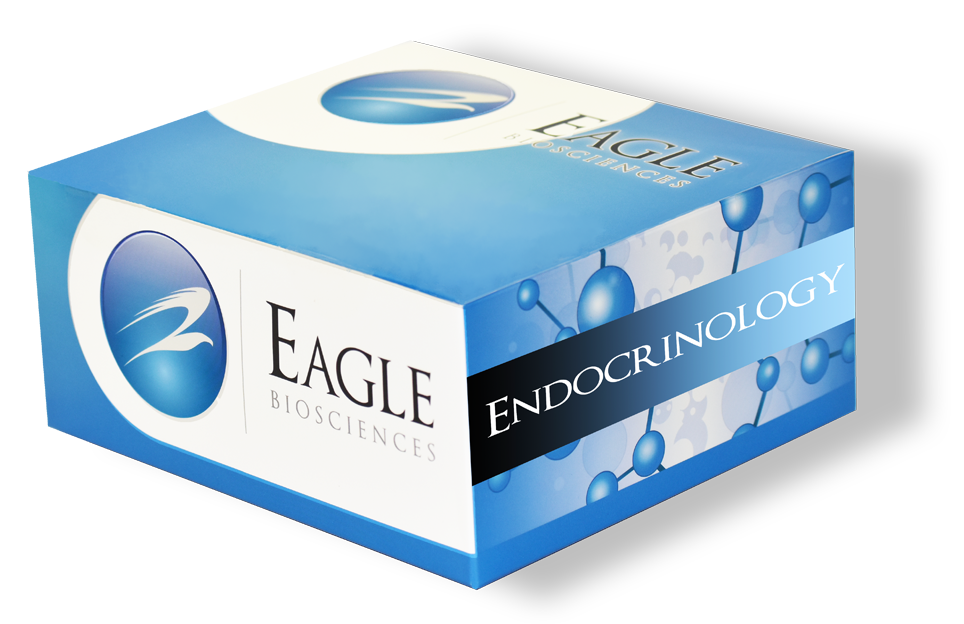Rodent Urocortin 3 ELISA Assay
The Rodent Urocortin 3 ELISA Assay is For Research Use Only
Size: 1×96 wells
Dynamic Range: 0.41.9 – 100 ng/mL
Incubation Time: 21 hours
Sample Type: Mouse or Rat Serum, Plasma
Sample Size: 25μL
Alternative Names: Mouse/Rat Urocortin 3, Mouse Rat UCN 3, Rodent Stresscopin, SCP
Assay Background
Urocortin 3 (Ucn3) or stresscopin (SCP) is a new member of the corticotropin-releasing factor (CRF) peptide family identified in the mouse and human. The CRF family of neuropeptides includes mammalian peptides CRF, urocortin 1(Ucn1) and urocortin 2 (Ucn2) or stress-related peptide (SRP), as well as piscine urotensin 1 and frog sauvagine. Mouse and human Ucn3 share 90% identity in the 38-aa putative mature peptide.
In the human, Ucn1 immunoreactivity was marked in the medulla, whereas Ucn3 was immunostained mostly in the cortex. The receptors for Ucn1, Ucn2, Ucn3 and CRF are all expressed in human adrenal cortex and medulla2), therefore these peptides are expected to play important roles in physiological adrenal functions. Ucn3 was also detected by RIA in human heart 0.74-1.15 pmol/g wet weight, kidney 1.21 pmol /g wet weight, pituitary 2.72 pmol /g wet weight and brain tissues 1-2 pmol /g wet weight. Furthermore, immunoreactive Ucn3 was present in human plasma 51.8 pmol/L and urine 266 pmol/L obtained from healthy subjects. It was also detected in human rectum 15.4 pmol/g wet weight and sigmoid colon 6.5 pmol/g wet weight. These data suggest that Ucn3 regulates the cardiac and renal functions as a local factor and a circulating hormone and plays some physiological or pathological roles in the modulation of gastrointestinal functions during stressful conditions in different manners from those of Ucn1.
Pharmacological studies showed that Ucn3 is a high-affinity ligand for the type 2 CRF receptor (CRFR2). In the rat, Ucn3-positive neurons were found predominantly within the hypothalamus and medial amygdala.5) Ucn3 fibers were distributed mainly in the hypothalamus and limbic structures. These data support that Ucn3 is an endogenous ligand for CRFR2 in these areas. The results also suggest that Ucn3 is positioned to play a role in mediating physiological functions, including food intake and neuroendocrine regulation.
In the mouse, Ucn3 was expressed in pancreatic beta-cells and in a mouse beta cell line, MIN6. High potassium, forskolin or high glucose could stimulate Ucn3 secretion from these cells.6) Ucn3 injections to the rat resulted in significant increase of plasma insulin level.6) Ucn3 also stimulated glucagon and insulin release from isolated rat islets. Pancreatic Ucn3 acting through CRFR2 was suggested to be involved in the local regulation of glucagon and insulin secretion.
Treatment with Ucn3 (SCP) or Ucn2 (SRP) suppressed food intake, delayed gastric emptying and decreased heat-induced edema. Thus Ucn3 (SCP) and Ucn2 (SRP) might represent endogenous ligands for maintaining homeostasis after stress, and could allow the design of drugs to ameliorate stress-related diseases. The use of CRFR2 selective agonists, Ucn2 and Ucn3, to treat ischemic heart disease was proposed because of their potent cardioprotective effects in murine heart and their minimal impact on the hypothalamic stress axis.
Ucn1 is able to bind to two types of G-protein coupled receptors: CRFR1 and CRFR2, whereas Ucn3 (SCP) and Ucn2 (SRP) bind exclusively and with high affinity to CRFR2. Ucn3 (SCP) is expressed in rat cardiomyocytes and the levels of Ucn3 (SCP) and Ucn2 (SRP) were increased by hypoxic stress. All these three peptide were shown to have potent cardioprotective effects in cells exposed to hypoxia/reoxygenation.
We have already developed mouse/rat urocortin 1 EIA kit (YK210), mouse urocortin 2 EIA kit (YK190) and rat urocortin 2 EIA kit (YK191). This time, as a part of tools for urocortin research, our laboratory developed mouse/rat urocortin 3 EIA kit (YK200), which is highly specific for mouse/rat urocortin 3 with almost no crossreaction to Ucn1 (mouse, rat), Ucn1 (human), Ucn2 (mouse), Ucn2 (rat), ACTH (mouse, rat), ACTH (human) and CRF (mouse, rat, human). The kit can be used for measurement of Ucn3 in mouse/rat plasma, serum and their brain tissue extracts with high sensitivity (The brain tissue extracts need to be treated with solid-phase extraction cartridges). It will be a specifically useful tool for Ucn3 researches.
Related Products
Mouse Rat Urocortin 1 ELISA Assay Kit
Rat Urocortin 2 ELISA Assay
Mouse Urocortin 2 ELISA Assay



